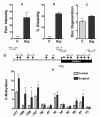DNA methylation of SPARC and chronic low back pain
- PMID: 21867537
- PMCID: PMC3182907
- DOI: 10.1186/1744-8069-7-65
DNA methylation of SPARC and chronic low back pain
Abstract
Background: The extracellular matrix protein SPARC (Secreted Protein, Acidic, Rich in Cysteine) has been linked to degeneration of the intervertebral discs and chronic low back pain (LBP). In humans, SPARC protein expression is decreased as a function of age and disc degeneration. In mice, inactivation of the SPARC gene results in the development of accelerated age-dependent disc degeneration concurrent with age-dependent behavioral signs of chronic LBP.DNA methylation is the covalent modification of DNA by addition of methyl moieties to cytosines in DNA. DNA methylation plays an important role in programming of gene expression, including in the dynamic regulation of changes in gene expression in response to aging and environmental signals. We tested the hypothesis that DNA methylation down-regulates SPARC expression in chronic LBP in pre-clinical models and in patients with chronic LBP.
Results: Our data shows that aging mice develop anatomical and behavioral signs of disc degeneration and back pain, decreased SPARC expression and increased methylation of the SPARC promoter. In parallel, we show that human subjects with back pain exhibit signs of disc degeneration and increased methylation of the SPARC promoter. Methylation of either the human or mouse SPARC promoter silences its activity in transient transfection assays.
Conclusions: This study provides the first evidence that DNA methylation of a single gene plays a role in chronic pain in humans and animal models. This has important implications for understanding the mechanisms involved in chronic pain and for pain therapy.
Figures





Similar articles
-
Lumbar intervertebral disc degeneration associated with axial and radiating low back pain in ageing SPARC-null mice.Pain. 2012 Jun;153(6):1167-1179. doi: 10.1016/j.pain.2012.01.027. Epub 2012 Mar 11. Pain. 2012. PMID: 22414871
-
Behavioral signs of chronic back pain in the SPARC-null mouse.Spine (Phila Pa 1976). 2011 Jan 15;36(2):95-102. doi: 10.1097/BRS.0b013e3181cd9d75. Spine (Phila Pa 1976). 2011. PMID: 20714283 Free PMC article.
-
Exercise attenuates low back pain and alters epigenetic regulation in intervertebral discs in a mouse model.Spine J. 2021 Nov;21(11):1938-1949. doi: 10.1016/j.spinee.2021.06.002. Epub 2021 Jun 9. Spine J. 2021. PMID: 34116218
-
Insight into neural mechanisms underlying discogenic back pain.J Int Med Res. 2018 Nov;46(11):4427-4436. doi: 10.1177/0300060518799902. Epub 2018 Oct 1. J Int Med Res. 2018. PMID: 30270809 Free PMC article. Review.
-
Defects in intervertebral disc and spine during development, degeneration, and pain: New research directions for disc regeneration and therapy.Wiley Interdiscip Rev Dev Biol. 2019 Jul;8(4):e343. doi: 10.1002/wdev.343. Epub 2019 Apr 11. Wiley Interdiscip Rev Dev Biol. 2019. PMID: 30977275 Free PMC article. Review.
Cited by
-
Plasticity of DNA methylation in a nerve injury model of pain.Epigenetics. 2015;10(3):200-12. doi: 10.1080/15592294.2015.1006493. Epigenetics. 2015. PMID: 25621511 Free PMC article.
-
Modulation of the Negative Affective Dimension of Pain: Focus on Selected Neuropeptidergic System Contributions.Int J Mol Sci. 2019 Aug 17;20(16):4010. doi: 10.3390/ijms20164010. Int J Mol Sci. 2019. PMID: 31426473 Free PMC article. Review.
-
Comprehensive analysis of N6-methyladenosine (m6A) modification during the degeneration of lumbar intervertebral disc in mice.J Orthop Translat. 2021 Dec 15;31:126-138. doi: 10.1016/j.jot.2021.10.008. eCollection 2021 Nov. J Orthop Translat. 2021. PMID: 34976732 Free PMC article.
-
Effects of methyl donor diets on incisional pain in mice.PLoS One. 2013 Oct 24;8(10):e77881. doi: 10.1371/journal.pone.0077881. eCollection 2013. PLoS One. 2013. PMID: 24205011 Free PMC article.
-
Overlapping signatures of chronic pain in the DNA methylation landscape of prefrontal cortex and peripheral T cells.Sci Rep. 2016 Jan 28;6:19615. doi: 10.1038/srep19615. Sci Rep. 2016. PMID: 26817950 Free PMC article.
References
-
- Boden SD, Davis DO, Dina TS, Patronas NJ, Wiesel SW. Abnormal magnetic-resonance scans of the lumbar spine in asymptomatic subjects. A prospective investigation. J Bone Joint Surg Am. 1990;72:403–408. - PubMed
-
- Samartzis D, Karppinen J, Mok F, Fong DY, Luk KD, Cheung KM. A population-based study of juvenile disc degeneration and its association with overweight and obesity, low back pain, and diminished functional status. The Journal of bone and joint surgery American volume. 2011;93:662–670. doi: 10.2106/JBJS.I.01568. - DOI - PubMed
Publication types
MeSH terms
Substances
Grants and funding
LinkOut - more resources
Full Text Sources
Medical
Miscellaneous

